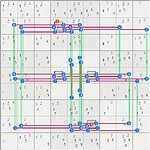Working on Allan model, I had the feeling that some specific patterns, close or belonging to the fishes family, could play a key role.
I was missing an example to open the discussion.
tarx0075 starts gives me an opportunity to do it. I doubt this is new, but I have no time to dig in all posts written on fishes. Anyway, applying it to Allan model lead to a wider scope, although most often, we will have pure “almost fishes”
Let’s start with tarx0075 example
- Code: Select all
........6..5..18...9...8.7....8.2.....3.1.2..4..5.3....6.....9...83..1..7.......4#tarx0075
1238 123478 1247 |2479 234579 4579 |3459 12345 6
236 2347 5 |24679 234679 1 |8 234 239
1236 9 1246 |246 23456 8 |345 7 1235
---------------------------------------------------------
1569 157 1679 |8 4679 2 |345679 13456 13579
5689 578 3 |4679 1 4679 |2 4568 5789
4 1278 12679 |5 679 3 |679 168 1789
---------------------------------------------------------
1235 6 124 |1247 24578 457 |357 9 23578
259 245 8 |3 245679 45679 |1 256 257
7 1235 129 |1269 25689 569 |356 23568 4
We will work exclusively on digits 4679, column 3467 and box 5.
I reduce the PM to that map focusing on used positions
- Code: Select all
47+ |479+ o 479+ |49+
- |4679+ o - |-
46+ |46+ o - |4+
------------------------------
679+ |- 4679 - |4679+
- |4679 - 4679 |-
679+ |- 679 - |679
-------------------------------
4+ |47+ o 47+ |7+
- |- o 4679+ |-
9+ |69+ o 69+ |6+
All cells with given ‘-‘
Unused cells ‘o’
Extra candidates ‘+’.
Next point what if ‘4’;’6’;’7’;’9’ is in cells r46c5.
We will consider each digit independently and conclude at the end.
1)4r4c5 => B5 and r4 occupied.
Here after the diagram for columns 3467
- Code: Select all
N24 N86 4R1 4R3 4R7
| | | | |
4c7 417 437 |
4c3 413 433 473
4c6 | 486 416 436
4c4 424 | 414 434 474
This diagram is shown following Allan Barker representation with “sets” in horizontal and “Link sets” in vertical. No missing candidate in horizontal, but some in vertical.
In that pattern, 4r2c4 + 4r8c6 false lead to a deadly pattern(locked fish four columns within three lines).
One at least of 4r2c4;4r8c6 must be true.
2)6r46c5 to clarify, I split in 2 cases 6r4c5 and 6r6c5
- Code: Select all
N24 N86 6R6 6R3 6R9 assuming 6r4c5
| | | | |
6c4 624 | 634 694
6c6 | 686 =|===|==696
6c3 | 663 633
6c7 | 667==|==697
N24 N86 6R4 6R3 6R9 assuming 6r6c5
| | | | |
6c4 624 | 634 694
6c6 | 686 =|===|==696
6c3 | 643 633
6c7 | 647==|==697
Same sub patterns as before, must have at least one of 6r2c4;6r8c6
3)7r46c5 split in 2 sub patterns
- Code: Select all
N24 N86 7R6 7R1 7R7 assuming 4r4c5
| | | | |
7c4 724 | | 714 774
7c6 | 786 | 716 776
7c3 | | 763 713
7c7 | | 767 777
N24 N86 7R4 7R1 7R7 assuming 7r6c5
| | | | |
7c4 724 | | 714 774
7c6 | 786 | 716 776
7c3 | | =743 713
7c7 | | =747 777
Same pattern, must be one at least of 7r2c4;7r8c6
4)9r46c5 split in 2 sub patterns
- Code: Select all
N24 N86 9R6 9R1 9R9 assuming 9r4c5
9c4 924 | | 914 994
9c6 986 | 916 996
9c3 ======= 963 | 993
9c7 ======= 967 917
N24 N86 9R4 9R1 9R9 assuming 9r6c5
9c4 924 | | 914 994
9c6 986 | 916 996
9c3 ======= 943 | 993
9c7 ======= 947 917
Again same pattern and the conclusion:
Whatever is the couple of digits solving r46c5, the 2 same digits will solve r2c4;r8c6.
This gives for sure r2c4<>2 and r8c<>6, but also a significant step in the six possible scenarios
4&6 r46c5 => 4&6 r2c4r8c6
4&7 r46c5 => 4&7 r2c4r8c6
. . .
7&9 r46c5 => 7&9 r2c4r8c6
Generalized “Almost fishes patterns”
That example uses only one pattern. This is a wide field to explore. I like to use Allan representation sets / link sets to open the topic.
Here examples of possible patterns. S1…Sn are sets as defined in Allan model (row, column, box or Cell/Node. We already know that one can mix boxes and rows/columns in a fish pattern. I don’t know if mixing cells/Node with rows, columns, boxes is realistic.
- Code: Select all
L1 L2 L3 L4
+ + + ( Y )
S1 . . .
S2 . . .
S3 x . . .
X => Y #X => #Y several interesting patterns like in URs
- Code: Select all
L0 L1 L2 L3 L4
+ + +
S1 . . .
S2 . . .
S3 X . . .
S4 Y . . .
X or Y and again, several sub patterns.
Surely other suggestions should come.
What is for sure is that you can bring in AIC’s such binary conditions as it has been done with UR’s.
champagne



